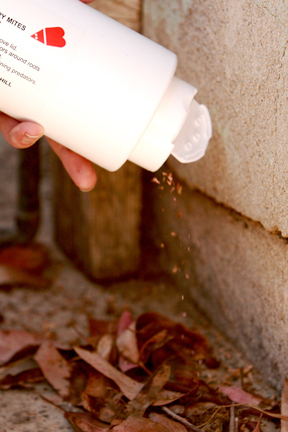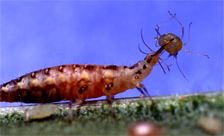The Bug Farm Blog
Spolight on:
Shangri La Botanical Garden
 Hurricane Ike's floodwaters destroyed the greenhouses and closed the Gulf Coast public gardens on September 27. They use non-toxic pest control methods consistent with their environmental and insect conservation goals. The bugfarm blog has a post about the dilemma as the staff prepared for Ike. Hurricane Ike's floodwaters destroyed the greenhouses and closed the Gulf Coast public gardens on September 27. They use non-toxic pest control methods consistent with their environmental and insect conservation goals. The bugfarm blog has a post about the dilemma as the staff prepared for Ike.
Vanishing Bees
"Some
believe that honeybee die-off is an indictment of the way we do
agriculture - too much pesticide sprayed on more and more land..."
Kyra Goes West
"I wound up at Rincon-Vitova rather serendipitously; I was in my
last year (last 3 weeks to be exact) of my undergraduate degree..."
|
|
|
| Seasonal Links
ATTRA Native Beesdiscusses using bees as pollinators, how to attract wild bees, list of suppliers.
Insecta-Flora Low's goldfields decorate California's largest green roof. Texas NaturalistJohnny jump ups on habitat plant list in Central Texas. Wild Farm AllianceIntegrating wild margins and agricultural easements; value of biodiversity for organic. Hedgerows for California AgricultureHow to choose and care for regionally appropriate plants that attract beneficial insects and prevent erosion. |
|
|
The Bug Farm Blog
We've started a blog at bugfarm.us.
We write about biological pest control--perspectives, questions,
updates, stories, and fun from the bug farm staff. AND you, the reader,
can participate with your insights, experiences and questions.
|
Fall Mite Clean Up

Release Hypoaspis in greenhouses now to kill over
wintering two-spotted spider mites. The better the clean up in fall, the
less severe the spider mites will be in spring. During spring and summer, use proactive releases of Phytoseiulus persimilis or Neoseiulus fallacis
so that spider mites do not become a problem. However, an important
part of cost-effective prevention is to put Hypoaspis to work in fall
before the cool, short days trigger spider mite females to
lay overwintering eggs and die.
Once plant debris is removed and spider mites turn
red and move into hiding, they are untouchable by predators until spring. They
hibernate in cracks around the floor and roof. Remove such over-wintering sites
as pots and covers. Use soapy water with orange oil to clean benches and floors
and spray purlins and roof supports with horticultural oil to kill mite eggs.
For more Info, check out our Spider Mite Bulletin. |
|
Lacewing Marathoners

An efficient green lacewing larva might consume 350 aphids, 11,200
spider mites or 3,780 scale crawlers! They are good at cleaning up eggs
and young larvae of many beetles and caterpillars, mealybugs,
whiteflies, thrips, leafhoppers and more without wasting time eating
the whole thing. They drink the juice and toss away the exoskeleton
terminating the prey before moving on. They compete in endurance as
well, walking seven miles as larvae. Launch these hungry long-distance
runners in pest hotspots.
To sustain these general predators, first control ants by baiting
their runs or turn mounds inside out. Then cultivate habitat for
beneficials. Corn stalks and sunflowers when shaken at dusk in the peak
of bloom will send lacewing fluttering overhead. Borders of alfalfa and
oilseed Brassicas, Beneficial Blend or Insecta-Flora seed mixes support lacewing and other natural enemies.
For more info, check out our Lacewing Bulletin.
|
Enhancing Farms and Gardens with Insecta-Flora Low

Insecta-Flora is a flower seed blend that blooms through the seasons and years providing habitat for
beneficial insects. Clovers and alfalfa are great habitat plants, but
sometimes the showy look of Insecta-Flora containing less grass and
legumes is preferred to the ever-popular and less expensive Beneficial Blend. Insecta Flora comes in Low (up to a foot high),
Standard, and High (3 foot high). The Low mix provides nitrogen-fixing
and erosion control as well as habitat.
Smaller beneficial
insects will fly a couple hundred feet to an island of flowers that
keep them going. Enhancing an upwind vineyard border yields a
beneficial welcoming committee for invading pests. Covering bare ground
with beneficial habitat mixes cuts heat reflection and dust to prevent
spider mite problems. Mow or weed-whip half at a time and then the
other half a few weeks later to concentrate the beneficials without
driving them away. Wait until the flowers set to encourage reseeding.
Here is our Insecta-Flora Bulletin in pdf.
|
Fungus Gnats Neutralized
Gnatrol is a microbial insecticide that attacks the maggots of fungus
gnats, shore flies, and other flies in the soil. The active ingredient Bacillus thuringiensis israelensis
(Bti) bacteria doesn't kill the flying adults; the maggots must eat it.
Hydroponic growers like Gnatrol's cost-effective control of fungus
gnats. Gnatrol WDG (water dispersible granules) is OMRI listed for
organic, and pending CA EPA approval. The liquid comes in 2.5 gallon
jugs and the graunles in 16 lb pails.
For more info, check out our Gnatrol bulletin.
|
|
|
|
|